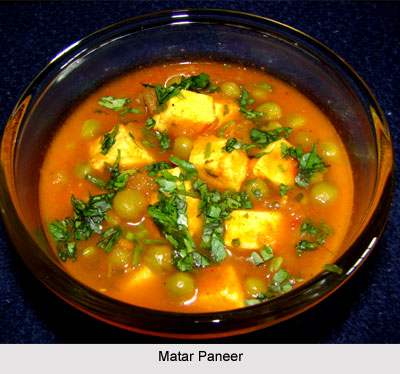 Matar Paneer is a delicacy that all Indians particularly northerners love. In India Matar Paneer is prepared with the mixture of spices and with the individual touch, are absolute master¬pieces. The most popular, Matar Paneer is made with moist pieces of sautéed cheese with sweet green peas wrapped in a luscious red sauce bursting with the fragrance of spices and fresh coriander leaves.
Matar Paneer is a delicacy that all Indians particularly northerners love. In India Matar Paneer is prepared with the mixture of spices and with the individual touch, are absolute master¬pieces. The most popular, Matar Paneer is made with moist pieces of sautéed cheese with sweet green peas wrapped in a luscious red sauce bursting with the fragrance of spices and fresh coriander leaves.
The flavour and texture of the paneer are of prime importance because if the paneer is dry and too solid, the cheese pieces will taste hard and rubbery, and the sauce will not penetrate the paneer, leaving it with a bland taste. It should be moist but not wet; and finally, its texture should be close and compact, not porous.
Ingredients of Matar Paneer
•Paneer 350 grams cut in small cubes
•12 tbsps asli ghee or Indian vegetable fat, or light vegetable oil
•500 gram finely chopped onions
•1 tsp finely chopped garlic
•2 tbsps finely chopped fresh ginger root
•2 tsps ground coriander
•1 tsp turmeric
•Â¼ -½ tsp each cayenne and black pepper
•1 tsp paprika
•500 gram finely chopped or pureed fresh ripe tomatoes, or canned tomatoes with their juice, chopped
•250 gram shelled fresh green peas, or a 315-g/10-oz package frozen peas, defrosted
•2 tsps salt
•2 tsps garam masala
•4 tbsps finely chopped fresh coriander leaves (or substitute 2 tbsps dry coriander leaves)
Method of preparing Matar Paneer
•Spread the paneer pieces on a piece of greaseproof paper and leave them to dry slightly for sometime.
•Heat 3 tbsps of the ghee over medium heat in a large heavy-bottomed pan, preferably one with a non-stick interior. When the ghee is hot, add cheese pieces. Fry the cheese, turning and tossing often to prevent sticking and burning, until lightly seared for about 5 minutes.
•Add the remaining ghee to the pan, and increase the heat to high. Add onions, and fry until they turn light brown for about 5 minutes, stirring constantly so that they do not burn. Add garlic and ginger, and fry for an additional 2 minutes. Add coriander, turmeric, cayenne and black pepper and paprika, all at once. Stir rapidly for a moment, and immediately add tomatoes. Cook for about 10 minutes until the mixture thickens to a pulpy sauce and the fat begins to separate, stirring often.
•Add 600 ml hot water, and bring the sauce to a boil. Reduce heat to medium, and cook the sauce, covered, for 20 minutes. Cool the sauce briefly. Then puree it in a blender or food processor, leaving the sauce a little coarse so that it has a certain texture.
•Return the sauce to the pan. Add peas, salt and the fried cheese, along with 125 ml hot water, and bring the sauce to a boil. Reduce heat to medium and simmer and cook for about 15 minutes until the peas are properly cooked. Turn off heat and let the dish rest, covered, for an hour before serving. When ready to serve, heat thoroughly. Fold in garam masala and chopped coriander leaves. Add salte to taste and serve.
Serve this beautifully coloured and exquisitely flavoured Matar Paneer with a fragrant pilaf such as Patiala Pilaf, Fragrant Pilaf Banaras Style, or Emperor"s Pilaf with Black Mushrooms. It goes beautifully with all plain baked or fried breads. To add to the meal, include a dal such as Lucknow Sour Lentils or Lentils with Garlic Butter or a cool raita such as Cucumber and Yogurt Salad or Dumplings in Fragrant Yogurt. Lentil Wafers and Sweet Lemon Pickle with Cumin go well as accompaniments. Precede the meal with a mild appetizer, such as Spinach and Mung Bean Dumplings, Silky Bean Dumplings or Cold Minted Potatoes for a complete vegetarian meal.




















